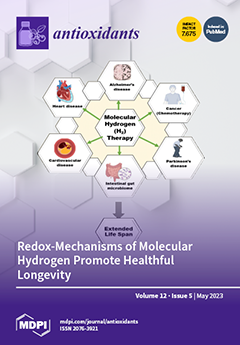This study aimed to establish the in vitro shoot culture of
Isatis tinctoria L. and its ability to produce antioxidant bioactive compounds. The Murashige and Skoog (MS) medium variants, containing different concentrations (0.1–2.0 mg/L) of benzylaminopurine (BAP) and 1-naphthaleneacetic acid (NAA) were tested. Their influence on the growth of biomass, accumulation of phenolic compounds, and antioxidant potential was evaluated. To improve the phenolic content, agitated cultures (MS 1.0/1.0 mg/L BAP/NAA) were treated with different elicitors, including the following: Methyl Jasmonate, CaCl
2, AgNO
3, and yeast, as well as with L-Phenylalanine and L-Tyrosine—precursors of phenolic metabolites. The total phenolic content (TPC) of hydroalcoholic extracts (MeOH 70%) obtained from the biomass grown in vitro was determined spectrophotometrically; phenolic acids and flavonoids were quantified by RP-HPLC. Moreover, the antioxidant potential of extracts was examined through the DPPH test, the reducing power, and the Fe
2+ chelating assays. The biomass extracts obtained after 72 h of supplementation with Tyr (2 g/L), as well as after 120 and 168 h with Tyr (1 g/L), were found to be the richest in TPC (49.37 ± 0.93, 58.65 ± 0.91, and 60.36 ± 4.97 mg GAE/g extract, respectively). Whereas among the elicitors, the highest TPC achieved was with CaCl
2 (20 and 50 mM 24 h), followed by MeJa (50 and 100 µM, 120 h). The HPLC of the extracts led to the identification of six flavonoids and nine phenolic acids, with vicenin-2, isovitexin, syringic, and caffeic acids being the most abundant compounds. Notably, the amount of all flavonoids and phenolic acids detected in the elicited/precursor feeding biomass was higher than that of the leaves of the parental plant. The best chelating activity was found with the extract of biomass fed with Tyrosine 2 g/L, 72 h (IC
50 0.27 ± 0.01 mg/mL), the strongest radical scavenging (DPPH test) for the extract obtained from biomass elicited with CaCl
2 50 mM, after 24 h of incubation (25.14 ± 0.35 mg Trolox equivalents (TE)/g extract). In conclusion, the in vitro shoot culture of
I. tinctoria supplemented with Tyrosine, as well as MeJa and/or CaCl
2, could represent a biotechnological source of compounds with antioxidant properties.
Full article






